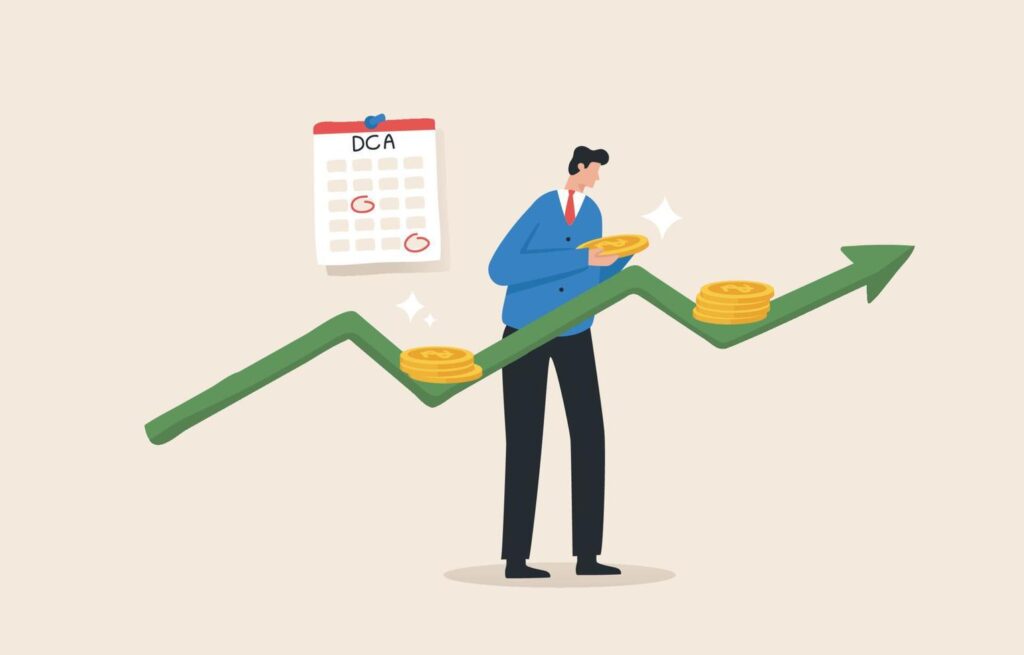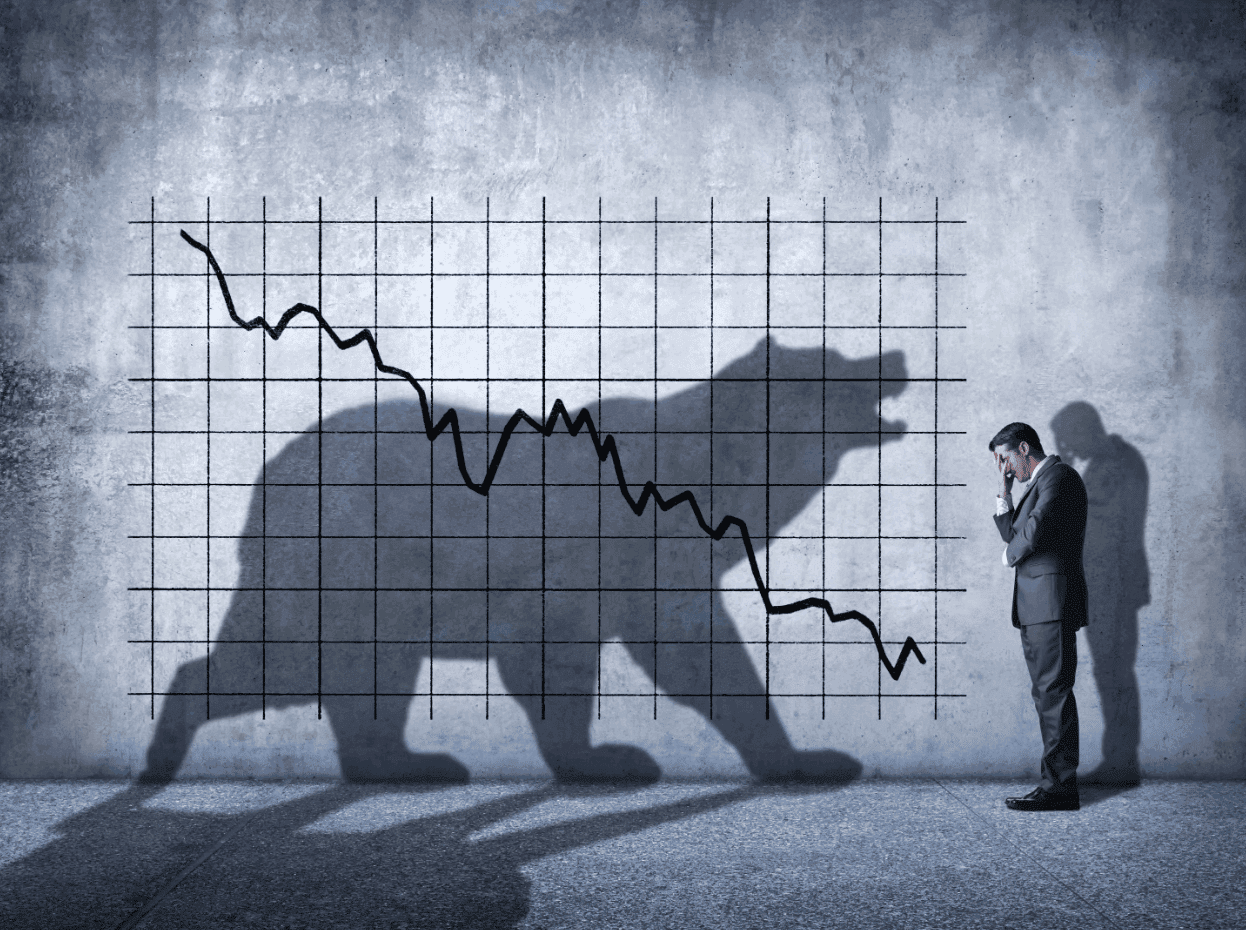Dollar cost averaging is a smart way to invest during a bear market.
By investing a fixed dollar amount into security or securities at fixed intervals, you smooth out your buying price over time.
This can help mitigate the effects of market volatility on your portfolio and potentially improve your returns.
Keep reading for tips on how to take advantage of dollar cost averaging during this down market.
What is dollar cost averaging?
Dollar cost averaging is an investing technique that involves buying a fixed dollar amount of a particular investment on a regular schedule, regardless of the share price.
The goal is to reduce the impact of market volatility on the overall purchase price.
For example, if you invest $100 in a stock each month for a year, you will end up buying more shares when the price is low and fewer shares when the price is high.
Over time, this technique can help to smooth out the ups and downs of the market and reduce your overall risk.
Of course, dollar cost averaging does not guarantee profits, but it can be a helpful way to reduce your exposure to market fluctuations.

What is a bear market?
A bear market is a financial market in which the prices of securities are falling or are expected to fall.
The term “bear market” is often used to describe a decline in the stock market, but it can apply to other assets as well, such as bonds, commodities, and even real estate.
Bear markets are typically characterized by pessimism and fear, as investors sell off their holdings in anticipation of further losses.
Although bear markets can be painful for investors, they also present opportunities to buy assets at bargain prices.
For this reason, some investors view bear markets as a natural and healthy part of the investment cycle.
- Consider reading: What should I do with my money now? – 10 Suggestions
How often do bear markets occur?
A bear market is a prolonged period of falling stock prices.
It is typically defined as a drop of 20% or more from the previous peak, although some experts argue that a decline of only 10% qualifies as a bear market.
Bear markets can be caused by many factors, including economic recession, high inflation, and interest rate hikes.
They can last for months or even years and typically result in substantial losses for investors.
While there is no hard and fast rule for how often bear markets occur, they tend to happen about once every three to five years on average.
As such, investors should be prepared for the possibility of a bear market at any time and should not be discouraged by short-term declines in the stock market.
Over time, the market has always recovered from these dips and gone on to new highs.

Why should you do dollar cost averaging during a bear market?
When it comes to investing in a bear market, there are different schools of thought.
Some investors believe that it is best to sell all of their stocks and wait for the market to rebound before buying back in.
Others believe that the key is to buy stocks when they are at their lowest point and then hold onto them until the market recovers.
However, there is a third option that is often overlooked: dollar cost averaging.
Dollar cost averaging simply means investing a fixed amount of money into security or securities at regular intervals.
For example, an investor might invest $500 into a stock every month.
By doing this, the investor can average out the cost of the security over time.
This can be beneficial during a bear market because it allows you to buy more shares when prices are low and fewer shares when prices are high.
As a result, you will end up with a lower average cost per share, which can lead to greater profits when the market eventually recovers.
Investing in a bear market can be daunting, but dollar cost averaging can help to take some of the risks out of the equation.
By investing regularly, you can lower your overall average cost per share and set yourself up for success when the market eventually rebounds.
- Consider reading: What are dos and don’ts of stock market investing?
How to take advantage of dollar cost averaging during a bear market?
Dollar cost averaging can be especially helpful during a bear market, when prices are falling.
By buying regularly, you’ll be able to take advantage of lower prices and end up with more assets than if you had waited to invest until prices bottomed out.
Of course, you could potentially lose money if prices continue to fall after you’ve made your purchases, but dollar cost averaging can help to reduce your overall risk.
One thing to keep in mind is that dollar cost averaging only works if you’re investing in an asset that you’re comfortable holding for the long term.
If you plan on selling as soon as prices start to rebound, you could miss out on some of the upside potentials.
However, if you’re investing for the long haul, dollar cost averaging can be a helpful way to smooth out the ups and downs of the market and keep your portfolio on track.

The benefits of dollar cost averaging in a bear market
Dollar cost averaging can be a helpful tool for investors who are looking to take advantage of lower prices during a bear market.
Of course, there is no guarantee that prices will rebound, but dollar cost averaging can help to set you up for success in the long run.
In general, dollar-cost averaging provides four key benefits that can result in better returns.
It can help you:
- Avoid mistiming the market: One of the biggest mistakes that investors make is trying to time the market. By investing a fixed amount of money at regular intervals, you can avoid the temptation to try to time the market.
- Reduce your overall risk: By investing in a bear market, you can reduce your overall risk. By buying when prices are low, you’ll be able to take advantage of the rebound when the market eventually recovers.
- Remove emotions from investing: Emotions can often cloud our judgment when it comes to investing. By investing regularly, you can take emotion out of the equation and make decisions based on your long-term goals.
- Think about the long-term: It’s important to remember that a bear market is only temporary. While it can be difficult to see past the current market conditions, it’s important to think about the long-term when making investment decisions.
By investing regularly, you can set yourself up for success when the market eventually rebounds.
Dollar cost averaging is a helpful tool that can be used to reduce your overall risk in a bear market.
Of course, there is no guarantee that prices will rebound, but dollar cost averaging can help to set you up for success in the long run.
Dollar cost averaging vs lump sum investing
When it comes to investing, there are two main strategies that people use to grow their money: dollar cost averaging and lump sum investing.
Both have their own pros and cons, and the best approach for you will depend on your individual circumstances.
Dollar cost averaging involves investing a fixed amount of money into security or securities at regular intervals.
The benefit of this approach is that it reduces the risk of buying when the market is high and prices are about to drop.
The downside is that it can take longer to reach your investment goals, and you may miss out on some potential gains if the market rallies before you have a chance to invest your lump sum.
Lump sum investing, on the other hand, involves investing all of your money into security or securities at once.
The advantage of this strategy is that you can take advantage of market fluctuations to buy low and sell high.
However, there is also more risk involved, as you could end up losing everything if the market crashes soon after you invest.
Which approach is right for you will ultimately come down to your individual risk tolerance and investment goals.

Tips for staying calm during a bear market
A bear market is a period of time when investments like stocks, bonds, and commodities decrease in value.
This can be a stressful time for investors, as it can be difficult to watch the value of their portfolios decline.
However, there are several things that investors can do to help stay calm during a bear market.
First, it is important to remember that bear markets are a normal part of the investing cycle and that they usually don’t last very long.
Second, investors should diversify their portfolios to include investments that may hold up better during a bear market.
Finally, it is important to maintain a long-term perspective and not make any rash decisions in response to short-term market volatility.
By following these tips, investors can help to minimize the impact of a bear market on their portfolios.
Is dollar cost averaging a good idea? – Conclusion
Dollar cost averaging is a good way to reduce the risk of investing in stocks.
It can help you purchase more shares when prices are low and fewer shares when prices are high.
This will even out your stock buying over time and result in a lower average price per share.
While it may not be the best strategy for everyone, dollar cost averaging is a sound investment method that can benefit most investors.
Have you tried dollar cost averaging before? What was your experience?







